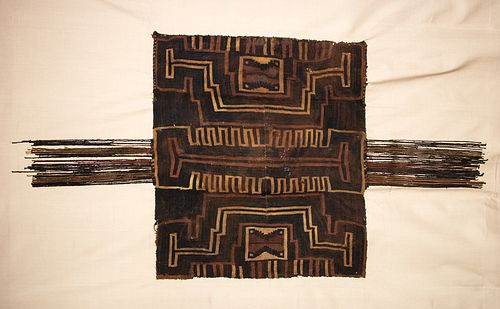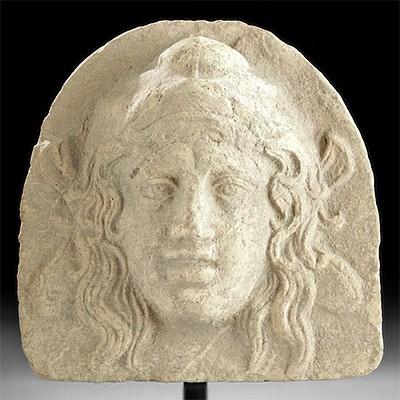Fine Sihuas Textile Tunic w/ Abstract Anthropomorphs
Lot 140
About Seller
Artemis Fine Arts
686 S Taylor Ave, Ste 106
Louisville, CO 80027
United States
Selling antiquities, ancient and ethnographic art online since 1993, Artemis Gallery specializes in Classical Antiquities (Egyptian, Greek, Roman, Near Eastern), Asian, Pre-Columbian, African / Tribal / Oceanographic art. Our extensive inventory includes pottery, stone, metal, wood, glass and textil...Read more
Estimate:
$3,500 - $5,000
Absentee vs Live bid
Two ways to bid:
- Leave a max absentee bid and the platform will bid on your behalf up to your maximum bid during the live auction.
- Bid live during the auction and your bids will be submitted real-time to the auctioneer.
Bid Increments
| Price | Bid Increment |
|---|---|
| $0 | $25 |
| $300 | $50 |
| $1,000 | $100 |
| $2,000 | $250 |
| $5,000 | $500 |
| $10,000 | $1,000 |
| $20,000 | $2,500 |
| $50,000 | $5,000 |
| $100,000 | $10,000 |
| $200,000 | $20,000 |
About Auction
By Artemis Fine Arts
Feb 27, 2020
Set Reminder
2020-02-27 10:00:00
2020-02-27 10:00:00
America/New_York
Bidsquare
Bidsquare : VARIETY SALE | Antiquities & Ethnographic Art
https://www.bidsquare.com/auctions/artemis-gallery/variety-sale-antiquities-ethnographic-art-4920
Around the world & back in time - be amazed at the treasures you will find. Antiquities from Egypt, Greece, Italy and the Near East, Asian, Pre-Columbian, African / Tribal / Oceanic, Native American, Spanish Colonial, Russian Icons, Fine Art, much more! Artemis Fine Arts info@artemisfinearts.com
Around the world & back in time - be amazed at the treasures you will find. Antiquities from Egypt, Greece, Italy and the Near East, Asian, Pre-Columbian, African / Tribal / Oceanic, Native American, Spanish Colonial, Russian Icons, Fine Art, much more! Artemis Fine Arts info@artemisfinearts.com
- Lot Description
Pre-Columbian, South Coast Peru, Sihuas Valley culture, ca. 500 BCE to 700 CE. A gorgeous tunic of a broad form that is tightly woven from camelid (alpaca or llama wool) fibers in earthy hues of brown, tan, citrine, and wheat. The rectangular tunic body is filled with large linear motifs that zigzag across the midsection, flow down the arms and sides, and create mirrored pyramids on the shoulders, and when seen together form two abstract, inverted anthropomorphs with red rectangular heads. The middles of the front and back peripheries are adorned with polychrome 'hair' tassels that would have given the figures a coiffure that covered the genitalia and intergluteal cleft of the wearer. A thin neck slit is situated across the middle of the tunic body and would have been the only area connecting the garment to the wearer. Mounted atop a museum-quality display fabric. Size (textile): 60" L x 31.125" W (152.4 cm x 79.1 cm); (display fabric): 75.75" L x 55.125" W (192.4 cm x 140 cm)
Provenance: ex-private Hans Juergen Westermann collection, Germany, collected in the 1950s to 1960s
All items legal to buy/sell under U.S. Statute covering cultural patrimony Code 2600, CHAPTER 14, and are guaranteed to be as described or your money back.
A Certificate of Authenticity will accompany all winning bids.
We ship worldwide and handle all shipping in-house for your convenience.
#150884Tunic body is sewn atop a modern brown-hued fabric panel for presentation and continuity. Losses to some interior and peripheral areas as shown. Fraying and loosening to some interior and peripheral fibers as well as front and back tassels, with light fading and staining to areas of original color, and minor creasing. Nice traces of original coloration throughout.Condition
- Shipping Info
-
All shipping is handled in-house for your convenience. Your invoice from Artemis Gallery will include shipping calculation instructions. If in doubt, please inquire BEFORE bidding for estimated shipping costs for individual items.
-
- Buyer's Premium



 EUR
EUR CAD
CAD AUD
AUD GBP
GBP MXN
MXN HKD
HKD CNY
CNY MYR
MYR SEK
SEK SGD
SGD CHF
CHF THB
THB














